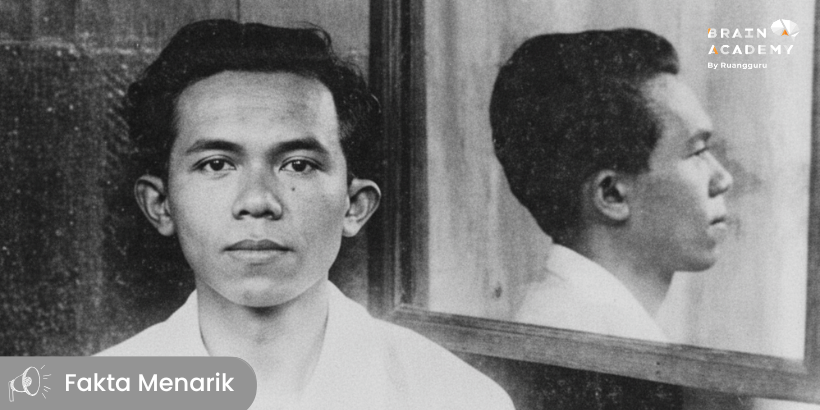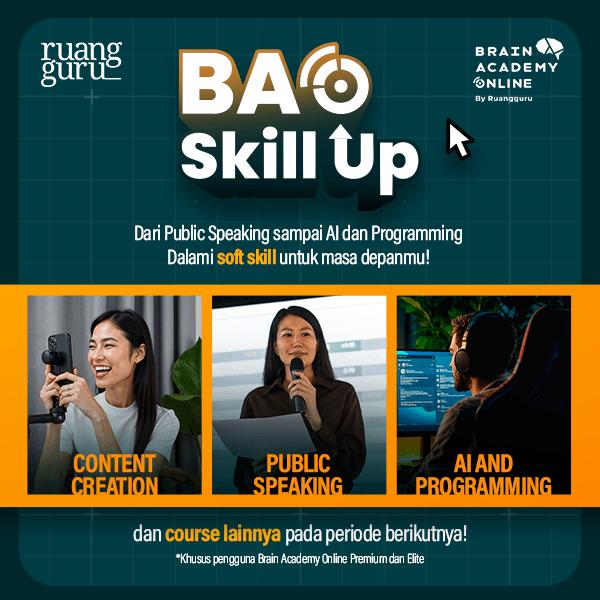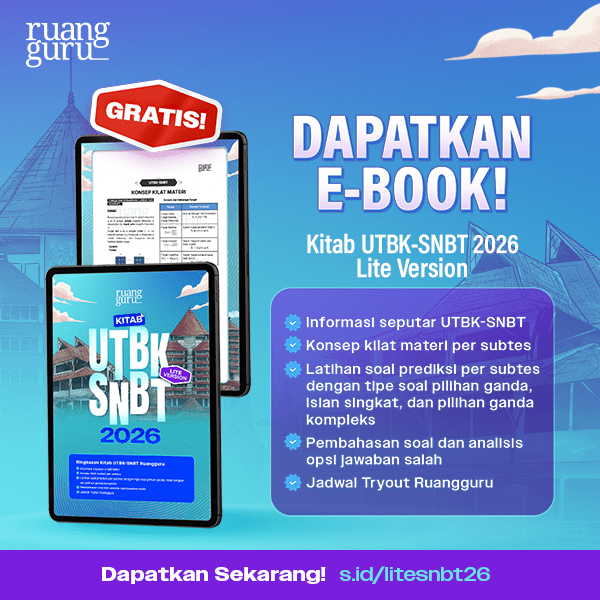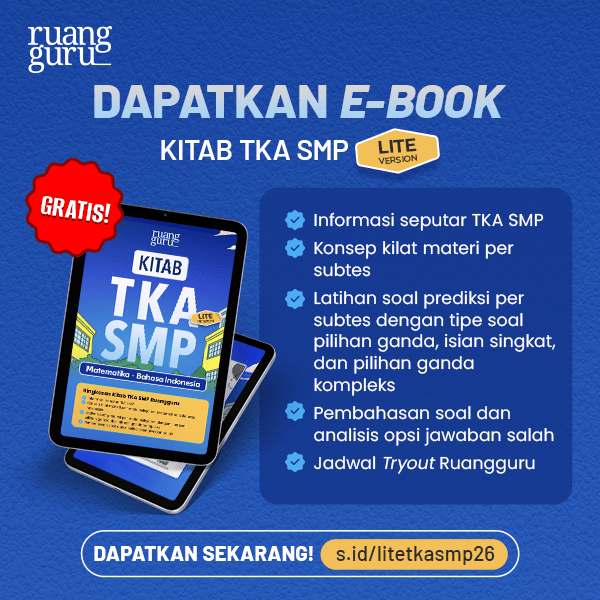Latihan Soal UTBK 2022: Bahasa Inggris

SBMPTN semakin dekat. Persiapkan dirimu dengan latihan soal dan pembahasan UTBK Bahasa Inggris 2022 berikut ini!
—

Questions 1-2 refer to the following passage.
United States citizens have always had a problem relating to the colonial period of their history. They have often thought that earlier period to be less relevant, less historically significant, than the later national period of their history. For many, the colonial era lacks seriousness; it seems trivial and antique and shrouded in nostalgia. For much of United States history, popular opinion has considered the century and a half of the colonial period to be simply a quaint prolog to the main story that followed the American Revolution.
In part this is because the colonial period has become a natural source of folklore and mythmaking. Since the United States, unlike older Western nations, lacks a misty past in which the historical record is remote and obscure, people have tended to transform authentic historical figures and events of the colonial past into mythical characters and legends. Unlike England we have no King Canute, no King Arthur, no Robin Hood to spin tales and legends about. Instead, we have transformed John Smith and Pocahontas, the Pilgrim Fathers, and Squanto (historical figures about whom we know a great deal) into fanciful and fabulous characters.
But such has not always been the case. In the decades following the Revolution, the colonial period was an integral and important part of history.
Topik: Reading Comprehension
Subtopik: Purpose of the passage
1. The primary purpose of this passage is to ….
- argue that colonial history had no influence on later periods in United States history.
- demonstrate that the colonial history of the United States is a mixture of legends and myths.
- present a rationale for teaching future generations of people in the United States about colonial history.
- explain why many people in the United States perceive colonial history in a particular way.
- suggest that a general ignorance of colonial history has caused people to repeat the mistakes of that era.
Kunci: D
Pembahasan: Option A is incorrect because this isn’t the purpose of the passage. The author doesn’t suggest that colonial history had no influence; in fact, “In the decades following the (American) Revolution, the colonial period was an integral and important part of history.” Option B is incorrect because this is too narrow to be the main purpose of the passage. The author says that the current U.S. perception of colonial history is a mythical one, but the purpose of the passage is to explain why that is. Option C is incorrect because this isn’t the purpose of the passage. The author doesn’t talk about the education of future United States citizens about colonial history; instead, the passage focuses on current U.S. perceptions of the time period (and also compares the perceptions of this time period to those of people in the decades following the American Revolution). Option E is incorrect because this isn’t the main point of the passage; the author doesn’t discuss repeated mistakes. Option D is the best choice. The passage starts by saying that people in the U.S. perceive the colonial period as a “quaint prolog” to U.S. history and is “shrouded in nostalgia.” The rest of the passage focuses on why U.S. citizens perceive colonial history in that way.

Topik: Reading Comprehension
Subtopik: Inferences
2. The author implies that which of the following is the most direct result of transforming colonial history into sentimental stories?
- It gives a much-needed nostalgic tone to an era otherwise lacking in emotion.
- It makes knowledge of colonial history more accessible to people of all ages.
- It fills in gaps where no actual historical data are available.
- It denigrates the work of those who study colonial history.
- It detracts from the historical significance of the colonial era.
Kunci: E
Pembahasan: Option A is incorrect because the author doesn’t suggest that the colonial period’s actual history lacks emotion. We don’t have enough information from the passage to make this inference. Option B is incorrect because the author doesn’t suggest this; the author doesn’t talk about age groups at all, so we don’t know the author’s view on whether the “sentimental stories” of the colonial period might be more accessible to younger people, for example. Option C is incorrect because it conflicts with what the author suggests. The author says that there is a lot of historical data available about the historical figures people have turned into myths: “we have transformed John Smith and Pocahontas, the Pilgrim Fathers, and Squanto (historical figures about whom we know a great deal) into fanciful and fabulous characters.” The author doesn’t mention any gaps in historical data. Option D is incorrect because this choice is too strong to be the likely result of transforming colonial history into myth. To “denigrate” means to belittle or to say bad things. It’s not suggested that the myth-making of the colonial era says anything bad about those who study the history of the period. Option E is the best choice. The author implies this at the end of the passage: “In the decades following the (American) Revolution, the colonial period was an integral and important part of history.” This was before people started making a myth out of the colonial period. Since the author says the colonial period was “an integral and important part of history” before the myth-making, this implies that the myths have detracted, or taken away, from the historical significance of that time.

Question 3 refers to the following passage.
One might think that hikers, seeking beauty and solitude in the wilderness, prefer to camp at previously untouched sites. However, researchers have discovered that small amounts of impact are often considered more acceptable than no impact at all. In one study, small fire rings were rated more acceptable than no fire rings. This may be because hikers, respecting that beauty, try to do as little damage as possible, and so would rather reuse an existing site than establish a new one. Or, perhaps tired hikers appreciate that existing “impacts” make it easier and quicker to set up cooking and sleeping areas.
Topik: Reading Comprehension
Subtopik: Purpose of component
3. The author discusses fire rings primarily to …
- explain why hikers prefer slightly used, rather than untouched, sites for camping
- show that hikers are concerned about inadvertently starting forest fires
- present one criterion by which hikers judge the quality of a campsite
- point out that previously used campsites often have more than one fire ring
- indicate that small fire rings are more often found at campsites than are large fire rings
Kunci: A
Pembahasan: Option B is incorrect because this isn’t the purpose of the author’s reference; the author doesn’t mention forest fires. Option C is incorrect because this isn’t the purpose of the author’s reference: hikers may like existing fire rings because they eliminate the environmental impact of creating a new one. This factor isn’t about the quality of the campsite. Option D is incorrect because this isn’t the purpose of the author’s reference. The author doesn’t specify how many fire rings typically show up at a campsite. Option E is incorrect because this isn’t the purpose of the author’s reference. “Small fire rings” are mentioned but aren’t compared to large fire rings, nor is it suggested that small fire rings are found more often than large ones. Option A is the best choice. The fire rings are an example of something that hikers like to reuse either because they “try to do as little damage as possible (to the environment), and so would rather reuse an existing site”, or because they appreciate the ease of an existing fire ring so they don’t have to make one themselves.

Question 4 refers to the following passage.
American archeologist Harriet Boyd Hawes excavated the ancient Greek town of Gournia at around the same time the palatial site of Phaistos was excavated, in the early 1900s. She is credited not only for her attention to a “common” rather than a palatial site, but also for her attention to artifacts that shed light on the day-to-day culture of the Minoans rather than just on their gold and lavish architecture.
Topik: Reading Comprehension
Subtopik: Summarizing a passage
4. Which of the following conclusions is best supported by the passage?
- Gournia is more representative of Minoan society than Phaistos.
- Gold and lavish architecture help to shed light on day-to-day Minoan culture.
- The work of Harriet Boyd Hawes contributes to our knowledge of standard Minoan living.
- Most archeologists would rather excavate a palatial site than a common site.
- Harriet Boyd Hawes is an archeologist who specializes in Minoan culture.
Kunci: C
Pembahasan: Option A is incorrect because this isn’t a conclusion we can draw from the passage. Gournia, a “common” site, revealed different aspects of Minoan society than the palatial (palace) site of Phaistos, but the palace was also part of Minoan society. Option B is incorrect because this conflicts with the passage. Harriet Boyd Hawes found “artifacts that shed light on the day-to-day culture of the Minoans rather than just on their gold and lavish architecture.” This means that the artifacts that shed light on day-to-day Minoan culture were different from the gold artifacts and fancy architecture. Option D is incorrect because this isn’t the best supported conclusion. The passage only talks about Harriet Boyd Hawes’s work, not about the preferences of other archeologists. Option E is incorrect because there isn’t enough information about this in the passage for us to draw this conclusion. We know she excavated this Minoan town, but we don’t know what other regions, if any, her work covered. Option C is the best choice. According to the passage, the artifacts Harriet Boyd Hawes found “shed light on the day-to-day culture (standard living) of the Minoans”.
Question 5 refers to the following passage.
After writing her first novel, The Woman Warrior, Maxine Hong Kingston realized that the American reading public was generally ignorant about Chinese Americans, so she deliberately put history lessons into her second novel, China Men—even listing historical facts, such as items of anti-Chinese legislation. Kingston contends that she felt compelled to do this, even at the risk of spoiling the dramatic moments in the narration, because sacrificing historical background for the sake of story in The Woman Warrior had not worked.
The “reviews of my first book made it clear that people did not know the history—or they thought I did not know it,” she says. “While I was writing China Men, I could not take that tension any more. So all of a sudden, right in the middle of the story, plunk—there is an eight-page section of pure history. There are no characters in it. It really affects the shape of the book and might look quite clumsy.”
The challenge that Kingston and other Asian American writers face is how to preserve the artistic integrity of their writing and be understood at the same time by readers whose ignorance of the cultural and historical background might necessitate explanations that interfere with the art.

Topik: Reading Comprehension
Subtopik: Inferences
5. The passage suggests that Kingston thought her approach to writing China Men might …
- distort historical facts
- make the novel seem awkward
- make the novel too long
- make the novel seem outdated
- appear pretentious
Kunci: B
Pembahasan: Option A is incorrect because the passage suggests the opposite of this. Kingston says that in her book, “there is an eight-page section of pure history. There are no characters in it.” This makes it sound like Kingston is not worried about distorting, or changing, historical facts. She believes the history is “pure” or accurate. Option C is incorrect because the passage doesn’t suggest this. Although Kingston says that in the middle of China Men “there is an eight-page section of pure history”, this doesn’t necessarily mean that the book was too long as a result of those pages. Option D is incorrect because the passage doesn’t suggest this; Kingston doesn’t refer to the concept of adding history to China Men as outdated. Option E is incorrect because this isn’t a suggestion made in the passage. Kingston says her addition of history into China Men “affects the shape of the book and might look quite clumsy”, but she doesn’t suggest that the history might appear pretentious (snobbish, conceited). Option B is the best choice. Kingston admits that her approach to writing China Men “might look quite clumsy” when she inserted several pages of history into the middle of the book with no characters or dialogue. Clumsy = awkward.

Masih kurang? Wah, kamu wajib coba paket UTBK Brain Academy sih. Tryout-nya sampai 23 kali loh! Ada modul belajar, rasionalisasi SNMPTN, sesi konsultasi via google meet atau chat, tes minat bakat, kelas pengembangan diri, laporan perkembangan belajar, ribuan latihan soal, dan masih banyak fitur lain yang bantu kamu masuk PTN favorit.
Tim Penyusun:
1. Hendra Bakti
![[IDN] CTA Blog Brain Academy](https://cdn-web.ruangguru.com/landing-pages/assets/cta/49210bfe-c949-4567-b773-0cd0fe4aa1f4.jpeg)













